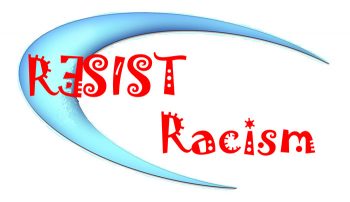
Social Justice Handbook
Speak out in your own circles
Being anti-racist means more than ridding yourself of racist attitudes, beliefs and behaviors. It means you’re also actively fighting it in your life on a daily basis.
Donating to activist organizations and protesting injustices are definitely good starts to becoming an ally. But that’s not enough. Actively rebutting prejudices in your own circles is key to lasting change, as those ideas and beliefs — unless challenged — are woven into the fabric of our culture.
What that means for you depends on who you are, where you live and who you’re interacting with.
Everyone has their own situation, in which we could help shape the mindsets, and thus the behaviors, of others. Ask yourself what messages you’re sending to your family, friends, workplace, places of worship and outside activities. What leadership are you providing or are you silent in the face of racism?
Unless one is really being intentional and thinking about how to interrupt the racist policies and practices that are surrounding me, then my silence is supporting that.
But when you say ‘Well, I’m not calling anyone names or doing anything hateful, [so] I have no responsibility’. But this web that surrounds all of us is reinforced by silence. So you have to speak up against it in the places where you are.
It’s easy to sight the obvious racism such as using race-based slurs or threats. But there’s a more subtle and insidious form of racist stereotyping that can be hard to pin down, like micro-aggressions.
Micro-aggressions
These are brief and commonplace verbal, behavioral things we do.
Micro-aggressions can be intentional or unintentional and sometimes even well-meaning. But they communicate hostile, derogatory or negative racial messages or assumptions to the receiver.
To even notice these instances requires educating yourself about the experiences of black people in America.
Addressing micro-aggressions is more an art than a science, and it requires a lot of creativity.
Micro-aggressions have two parts: One is the conscious communication of the initiator, which was likely intended to be a surface-level compliment. Then there’s the unconscious meta communication, which is the message the micro-aggression sends.
Make the invisible, visible. The perpetrator may be unaware that they have engaged in demeaning or offensive comments.
Shift from the focus of what the person intended to the impact.
They say, ‘That wasn’t my intention at all. Why are you so sensitive?'”
You lose the argument when you focus on intention because you can’t prove intent. Focusing on the impact as influenced by the significance.
Steering the conversation away from a problematic remark or joke to communicate that its offensive. Model good behavior to other people present, and you can have a later conversation with the person about why his joke was inappropriate.
‘You’re so articulate’ or ‘You don’t sound black.’
This is offensive to a lot of black people.
When a white person says it, it usually implies they didn’t expect to hear intelligence from a black person. The black person didn’t fit the white person’s offensive stereotype, so the white person complimented them for surprising them.
Say: “I know you meant that as a compliment, but unfortunately that connects to a larger history of people being surprised that black people can speak so well, make your compliment something more specific about the content of someone’s speech rather than commenting more generally on people being articulate.
’Don’t blame me. I never owned slaves.’
This assumes that as the US Civil War concluded, so did racism, when really it has continued in new forms.
Say, ‘People aren’t asking you to accept blame, people are asking you to see how all of us are connected in society. So it’s important to understand how the system is disadvantaged and take responsibility for working for a more just society for all.'”
‘White privilege doesn’t exist.’
Differences in racial privilege show up at a personal level, too. White privilege also means not having to stress over whether your skin will cost you a job or even an interview. It’s not having to worry whether your skin color was the reason for your mortgage application denial.
‘All lives matter.’
All lives do matter, but in this context it’s black lives that seem to matter less when they’re not being treated with respect.
Those who say “all lives matter” may be interpreting “only black lives matter,” which isn’t the case. The call to action means “black lives matter, too.” So when someone says “all lives matter” without acknowledging the movement’s point, they’re ignoring the racism exemplified in police interactions that ended badly.
Imagine at a funeral that someone is mourning the death of a loved one and you say, “All deaths matter.” Both scenarios are insensitive to the pain of the people suffering in this moment.
THE RACE GAP
Inequality between white and Black Americans persists in almost every aspect of society and the economy. Black people have less education, less wealth, poorer health and shorter lifespans. Many have labeled systemic racism amid the mass protests that followed the killing of George Floyd, a Black man, by a white Minneapolis police officer in May.
There has been progress in recent decades. But wide gaps — rooted in the legacy of slavery, segregation and discrimination — have endured or widened in the years since the civil rights victories of the 1960s.
FOOD INSECURITY
Black households are two and a half times more likely to experience food insecurity than white households.
One in every five Black households experienced food insecurity in 2018.
About one in ten Black households included a member who ate less food than they needed because they didn’t have enough money.
A survey showed that food insecurity during the COVID-19 pandemic hit a national rate of 23% — the highest on record — including nearly a third of Black households.
Out of every 100 Black households, 21 sometimes have difficulty providing enough food
EDUCATIONAL ATTAINMENT
Less than a third of Black students attain a bachelor’s degree or higher, compared to almost half of white students.
Many Black Americans see a lifetime of social and economic disadvantages. A high-quality preschool can help close early skills gaps, but only 15% of Black children attend one, compared to 24% of white children.
More than 65 years after the U.S. Supreme Court outlawed school segregation, Black children often still attend highly segregated and underfunded schools. Predominantly non-white districts spent $2,000 less per student on average than the mostly white districts, largely because schools are financed by local property taxes.
Bachelor’s degree attainment
The 16 percentage point gap between Black and white students who have bachelor’s degrees has remained steady for two decades.
STUDENT LOANS
Black undergraduate students owe about $7,000 more in student loans on average than their white peers after graduation.
Black students borrow and default more because they are more likely to come from low-income families.
HEALTHCARE
Black adults are more than 1.5 times less likely to have health insurance than white adults.
The gap in coverage between white and Black adults had been almost cut in half after the 2010 passage of the Affordable Care Act, but progress has since stalled. The remaining gap may be a factor of lower incomes or the types of jobs Black people are more likely to hold. But the disparity in coverage means Black people are more likely to avoid care due to costs.
Rates of uninsured people
THE JUSTICE SYSTEM
On average, Black male offenders received federal sentences almost 20% longer than white male offenders for the same crime.
Black Americans face a higher chance of imprisonment. In 2017, Black adults made up 33% of the U.S. prison population despite accounting for only 12% of the nation’s adults. In contrast, white people made up 30% of the prison population but 64% of the country as a whole. Black people also face longer sentences for similar crimes, and have a greater chance of dying from an encounter from a police officer, compared with white people, according to U.S. government studies.
VOTING
In 2016, 1 of every 13 Black people lost their right to vote due to a felony conviction, compared to 1 in every 56 non-Black voters.
But in 2016, Black people made up a disproportionate share of the more than 6 million people estimated to have lost their right to vote because of a felony conviction. More than half of states restrict voting while in prison, or on parole and probation. And more than one in five states permanently disenfranchise at least some people with criminal convictions.
In 2016, more than 7% of the voting age Black population in America was disenfranchised compared to 1.8% of the non-Black population.
WEALTH
Black families have one-tenth of the median net worth that white families have.
The striking gap between Black and white family wealth results from disparities across the U.S. economy. Black people are about twice as likely to be unemployed. The Black median household income is 57% that of white families, according to a 2017 Federal Reserve study.
The wealth gap is growing, and persists even for people with the same education level. The median net worth of families headed by a white person with a bachelor’s degree was $397,000 as of 2016; for households headed by a college-educated Black person, it was $68,000 — less than a white person without a college degree.
Median net worth
Black Americans have one tenth of the net worth of white Americans. Nearly one in five Black households has zero or negative net worth, compared to nearly one in ten white households.
RETIREMENT
Black households nearing retirement have a median savings of $30,000, which amounts to one quarter of the amount held by white households. With less savings, they are more likely to rely on Social Security benefits as their main source of retirement income.
Almost half of Black people receiving Social Security benefits receive at least 90% of their income from the program.
Black households near retirement age (55-64) had just a fourth of the savings held by white families for retirement in 2010.
LIFE EXPECTANCY
Black men have a life expectancy of 72.2 years, more than four years less than white men at 76.6 years.
In the CDC’s earliest records, at the turn of the last century, white people lived more than 30% longer than Black people, on average. The gap has decreased, but stayed largely stable through the 1960s to the 1990s. Increases in Black life expectancy since then have been attributed to reductions in HIV/AIDS deaths and homicide. The disadvantages Black people encounter throughout life in areas such as education, health care and housing contribute to the shorter life span.
In the COVID-19 pandemic, Black people have suffered higher infection and death rates. The Brookings Institution notes that densely populated neighborhoods with lack of nearby health resources may account for the difference, along with the higher presence of Black people among “essential” workers kept on the job throughout the crisis.
Life expectancy
The life expectancy gap between Black and white people has narrowed over a century but remains at four years. Chronic diseases, such as heart conditions or cancer, strike Black people at higher rates than white people.
***********
SOURCES:
https://www.cnn.com/2020/06/05/health/racial-microaggressions-examples-responses-wellness/index.html
Apple News: Reuters November 26, 2020

